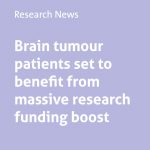The patient experience: what are your top tips?
Following last week’s inspiring and thought provoking BBC Radio 4 Today programme with Nick Robinson and Tessa Jowell talking bravely about their experiences with cancer, we set out to expand upon the 4 key themes of their discussion. You can read about them here:
- Day 1 – Adaptive brain tumour trials
- Day 2 – Brain tumour data
- Day 3 – Combination therapies and brain tumour treatment
Today Helen Bulbeck, brainstrust’s Director of Services and Policy tackles the final theme from the programme – your experience.
On the one hand this should be the easiest to write about (after all, its in brainstrust’s DNA) but it is so complex; there is so much at play.
Why is it so hard to get right?
Why is it so hard to ‘get patient experience right’? How do you tread that fine line between telling the truth and nourishing hope? Poor communication is associated with worse clinical and psychosocial outcomes, worse control and worse adherence to treatment; it causes confusion around diagnosis and prognosis which means that stress levels are high for everyone. There will always be discomfort when talking about a life limiting, or life changing diagnosis, but having these conversations in a sensitive, honest and supportive way can be transformative.
Handled well, a patient and their caregiver should be secure with the uncertainty that a brain tumour diagnosis brings, be open about not knowing and taking risks, and know that their inner dialogue is constructive. Have a look at our guide for some pointers about how to have a good conversation. Sadly, we know that these conversations are not always handled well and that people are not always told that they have a brain tumour in a supportive way. The National Cancer Patient Experience Survey evidences this. Only 32% of you were given a care plan. 38% of you didn’t understand the explanation about what was wrong with you. A little over 40% of you felt that you had enough support during and after treatment.
Yes – it is a complex pathway, full of twists and turns, and unexpected moments (cancer treatment plans rarely progress linearly – but even knowing to expect the unexpected can help).
You are the expert on you
In medicine, data points, clinical trials and experience guide choices in the road to be taken. After all it is our (the patient’s) road map – we look to our clinical team for guidance but ultimately the decision which way to go is ours. And this is when resilience, the ability to be agile is key. The patient is the expert on them – on their social circumstance, their appetite for risk, their context, their values and preferences. The clinician is the expert on diagnosis, treatment options and outcomes.
So what makes a good experience? How do you respond to emotion, deal with the stress of living with a brain tumour, manage expectations, nourish hope when at times the situation is bleak? As a clinician you can’t do it all. The professional obligations begin with designing effective and safe cancer treatment plans individualised to each patient, their goals, their physiology, and the biological aspects of their cancer. They must also manage the symptoms of the disease, its treatment, and the myriad of psychosocial, spiritual, and physical distresses accompanying a cancer diagnosis. You can read more on this here.
Stepping up to the mark – communicating well
As patients and caregivers we need too to step up to the mark. There are some guiding principles which will help us to make sure we have a good experience:
- People must stop asking ‘are you ok?’ (nobody ever answers this with the whole truth) and start asking ‘what are we struggling with the most?’ And if we aren’t asked it then we need to make sure we are asked, or reflect on the question regularly ourselves. You don’t need to know the answer but just saying it to someone can unlock the challenge.
- Prepare for consultations by talking with your friends and family about what would be a good outcome before you knock on the doctor’s door. Tell the clinician what you want to get out of the consultation. Revisit this at the end of the consultation. Summarise next steps and then think who is in your team who could help you with these actions.
- Give those around you some pointers as to how they can help. Be specific in your ask and don’t feel bad about it. If you were in their shoes you’d want to help.
- Read, read and read some more. That way any decision you make will be an informed one. And if you don’t want to do the reading ask someone close to you to do it and distil the key messages for you.
- Ask about clinical trials. Only 24% of patients were asked if they would be interested in research. It is incumbent upon us, the patient community, to ask whether there are any appropriate trials and how do you donate tissue, if you are having surgery.
As friends and family of people with a brain tumour, we need to be thoughtful, considerate and respectful. Some tips we have heard on our ten year journey supporting people with a brain tumour at brainstrust include:
- It’s fine to say ‘I don’t know what to say’
- Be specific in your offer of help, not ‘how can I help’ but, ‘I can help you with transport’, or ‘can I cook you a meal’. And it’s ok to offer more than once.
- If you know someone who has died from a brain tumour, we don’t always wish to know.
- Sometimes it’s good to talk about something else.
- It’s good to laugh
- Don’t judge the patient if they chose to work
- Support with any diet or lifestyle changes, for example many people with a brain tumour decide to reduce sugar intake
It only takes seconds for a clinician to ask you ‘what do you need to have an improved experience?’ And you need to know what to say. Talk to us – we can help you articulate it.
Making the conversation better – what’s worked well for you?
What’s your top tip for a good experience for you? Let’s start the conversation.
You can share your tips on our facebook page: www.facebook.com/brainstrust or email hello@brainstrust.org.uk





